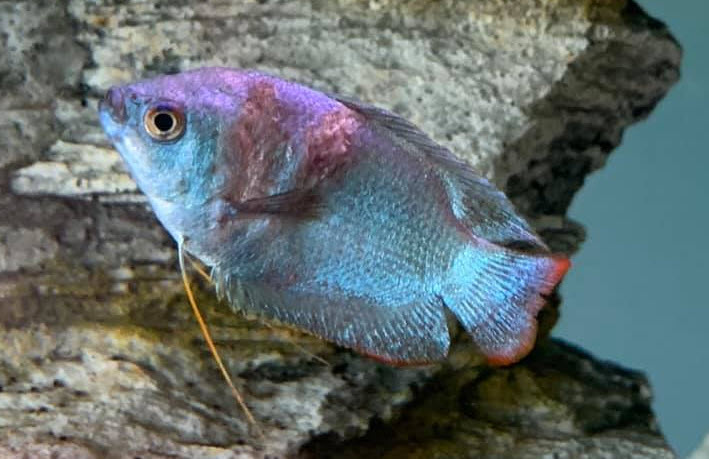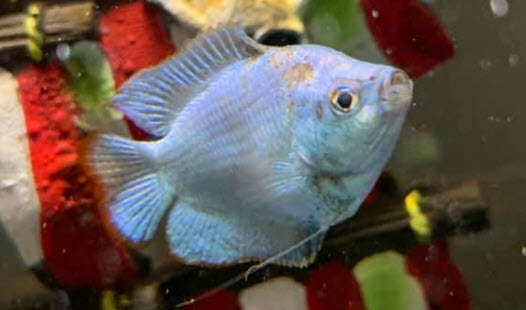
A comment to this page is helpful here:
“We have just lost six out of seven dwarf gouramis. They all died over the course of 3 weeks with some going very quickly and others dying slowly. I expect the last one to go any day now. It is such a shame as they are beautiful fish with amazing personalities but I won’t be purchasing anymore. It’s awful watching, waiting for them to die. I knew nothing of this disease before purchasing them and when I asked my local shop about it (after purchase) they just said dwarfs are more susceptible to some illnesses.”
There is a very beautiful fish which many beginners buy for their aquarium called the “dwarf gourami” (Trichogaster lalius). It comes in a host of beautiful varieties including powder blues, flame reds and neon blues. We do not recommend buying any dwarf gouramis, period. At least 50% of them will die in six months to a year due to an incurable virus disease.
This disease seems to be a combination of a virus AND a defect that occurs with interbreeding dwarf gouramis. It has not been found in wild strains of the dwarf gourami. I suspect breeders will figure out the genetics and start breeding resistant strains soon.

Dwarf gourami disease seems to infect gouramis when they are very young and then pop up and kill them rapidly six months to a year later. And typically it won’t spread to other species of fish. So, if you have dwarf gouramis already, you can safely leave the dwarf gouramis in a community tank. And note that maybe you will be one of the lucky ones whose dwarf gouramis do not have the virus.
Dwarf gourami disease is contagious among dwarf gouramis when they are fry. BUT if a dwarf gourami in a tank full of dwarf gouramis starts showing symptoms of the disease, ALL the other dwarf gouramis will have the virus and will probably soon show symptoms. So there is little point to quarantining or euthanizing.

Starting about 2008, aquarium dealers and hobbyists noticed a greatly increased mortality rate in all varieties of dwarf gouramis (Trichogaster lalius). It appears to be largely due to a virus. The virus is called an “infectious spleen and kidney necrosis virus (ISKNV)”. This virus is a megalocytiviruse, a type of iridovirus (“Iridovirus Disease in Two Ornamental Tropical Freshwater Fishes: African Lampeye and Dwarf Gourami”, Sudthongkong et. al., 2002). The virus appears to have originated in Southeast Asia but it has now spread to pretty much all populations of inbred dwarf gouramis.

Symptoms are varied and include loss of appetite, bloat, bumps, lesions on the body, patches of pale or white coloration (especially prevalent on the head) and high mortality rate. Basically ANYTHING unusual on the skin of a dwarf gourami indicates they have the virus. Just a small lump is a problem with a dwarf gourami. Often the fish simply die overnight with no symptoms.

The virus is very unusual in that it appears to lie dormant for six months to a year. It then breaks out and typically kills the dwarf gourami very quickly, in one to ten days. If there are more than one dwarf gourami in a tank they often will die at intervals of a month or more. As it is a virus there simply is no cure. The virus which causes this disease has only rarely been found in other tropical fish. But it is a deadly plague to the dwarf gourami. Virtually all the time dwarf gourami disease does not spread to other fish.

It is possible that, like many other intractable and incurable fish diseases, dwarf gourami disease responds well to having a crystal clear, well filtered tank with UV sterilization. But this is an unproven hypothesis.

The honey gourami (Trichogaster chuna) is a good substitute as they are only about two inches long (dwarf gourami get to 3 1/2 inch). The honey gourami is just a golden yellow to orange without the blue or red coloration of the dwarf but it doesn’t appear to get dwarf gourami disease. The honey gourami is also more mellow than the dwarf gourami.

Aquarium Science Website
The chapters shown below or on the right side in maroon lead to close to 400 articles on all aspects of keeping a freshwater aquarium. These articles have NO links to profit making sites and are thus unbiased in their recommendations, unlike all the for-profit sites you will find with Google. Bookmark and browse!

